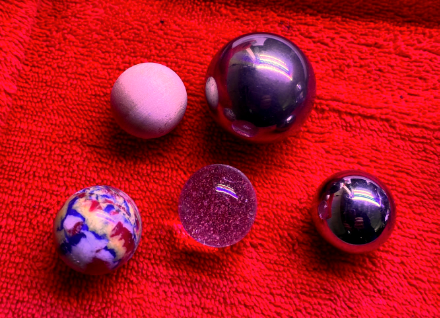Rolling Spheres - Tracks & energy
Tracks of spheres relative position and motion
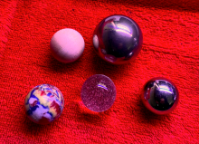
Tracks are amazing.
Evidence of what was, but only enough to tease you into wanting to learn more.
Overview
- Pedagogical overview
- Activity - What's my track?
- Lab notes
- Lab notes 1- What's my track?
- Lab notes 2 - Mystery track solutions
- Lab notes 3 - Mystery track solutions
- Lab notes 4 - Mystery collisions 1
- Lab notes 5 - Mystery collisions 2
- Support materials
- Mystery collision 1
- Mystery collision 2
- Energy data sheet - Kinetic energy, potential energy, gravity and conservation of energy
Pedagogical overview
A plan for exploring the tracks of spheres to infer their motion, interactions, and energy transfer. Includes discussion on kinetic energy, potential energy, gravity energy, and conservation of energy.
This activity uses a learning cycle lesson plan with the purpose of creating disequilibration or cognitive dissonance about what learners know about shadows and the shadows cast by the Sun. Information classified as Earth and physical science with strong science process support from relative position and motion.
Related study topics:
- Balance & stability
- Motion unit: Spinners: tops, zoomers, twirlers, rollers: wheels, wheels & axles, cups, & spheres
- Relative Position and Motion
- Ramps - explore ramps and ball runs to discover the relationships of variables for height, weight, distance travel, speed, jump, roll, crash, of spheres. hot wheel cars, and other vehicles.
- Simple machines
- Levers
- Roller coasters and marble runs...
Let's dig deeper and review how learners might construct the science content knowledge and how science inquiry and process skills might be included.
Disequilibrium might occur as the learners explore the tracks the spheres make and find that they do not leave a c0ntinuous line, that when they collide the tracks do not intersect, and the collisions actually not on the paper, but above the paper a distance equal to the radius of the spheres from the dots on the paper.
Equilibrium might occur when learners examine the evidence and discuss what is happening. Sometimes with hints about alternative ways of thinking about what what they thought in light of the new evidence.
Along with the science content, science inquiry and process skills necessary to construct this information could also be analyzed and specific instruction included in the lessons.
Supporting inquiry and process include: observation, inference, change, systematic collection of data, reasoning cause from effect, and relative position and motion, measurement, labeling tracks on paper, and communication.
Concepts
- The surface of a sphere interacts with the surface and other spheres or objects when they collide.
- Force is a push or pull.
- More massive spheres will transfer more force than less massive spheres.
- Faster spheres will transfer more force than slower spheres.
- Mass and speed can combine (momentum) to change the force transfered.
- The angle of collision will affect the transfer of force. Direct angles will transfer more force.
Outcomes
- Describe the tracks made by each sphere and the properties that make them unique.
- Describe tracks from a collision and explain some properties of the objects and the collision that make them unique.
- Identify possible explanations for a set of mystery tracks.
Focus question
- How do spheres interact with different surfaces?
- How do spheres roll?
- What kind of track will different spheres make?
- What will determine the speed of a sphere rolling down an incline plane?
- What happens when spheres collide?
- What happens when spheres collide with a slider?
- How do spheres collide with other spheres?
- How can you make a sphere curve?
Scoring guides suggestions (rubric)
Shadows and the Sun(scoring guide)
Top level
- Tracks are unique physical evidence created by an objects interaction (sphere) with a surface based on the properties of the object (sphere) and the surface (carbon paper, paper, and floor or table top).
- When the spheres interact with a surface (carbon paper ...) they make unique tracks based on their speed and weight and the surface.
- Spheres interact with the carbon paper and make marks.
Lower level
Activity 1 - What's my track?
Materials
- Ramps to make an inclined plane, different sizes and masses of spheres, carbon paper
- Lab note -
Focus questions:
- How do spheres interact with different surfaces?
- How do spheres roll?
- What kind of track will different spheres make?
- What will determine the speed of a sphere rolling down an incline plane?
Learning outcomes:
- Describe how different spheres interact with different surfaces.
- Identify spheres by the tracks they make.
Suggested procedures overview:
- Put learners in groups, focus their attention, and assess their initial understanding of the focus questions.
- Activity - Roll spheres and collect their tracks to identify the spheres and tracks they make.
Exploration - Motion of a Rolling Sphere
- Put learners in pairs.
- Do the activity Observation and inference of ancient tracks.
- Ask. What kind of tracks do think spheres would make?
- Do spheres interact with surfaces?
- Do different spheres make different tracks?
- How do spheres roll?
- Will spheres rolling down an incline plane at different speeds make different tracks?
- Can you identify different spheres from their tracks?
- Can you determine how a sphere rolled by its tracks?
- Ask. How could we collect information to answer these questions?
- Demonstrate how to collect tracks.
Use a ruler and a piece of wood to make a ramp that is about 10 cm. above the table. Position a small sphere at the 20 cm. mark of the ruler. Now release the sphere and let it roll down the ramp onto a piece of white paper which is covered by carbon paper. - Discuss procedure to collect tracks ... See possible procedure on Lab note - rolling spheres
- Tell learners they explore spheres, their tracks, and collect evidence so they will be able to observe mystery tracks and explain what the interactions were.
- Tell they will be given the rest of the period to explore, share their explorations the next class period and create their mystery tracks. Then they will exchange with another group and explain how they were made.
- Explore ...
Invention -
- Decide what different tracks to share to include enough examples so learners will be successful explaining mystery tracks.
- Have the learners display their tracks so everyone can see them and share how they made them
- Might include:
- A track for each kind of sphere
- A track for different collisions with a stationary object: small sphere, large sphere, ...
- A track for different collision: Small v small, small v large, large v small, ...
- ...
Discover
- Create a mystery set of tracks.
- Exchange mystery tracks.
- Explain how each mystery set of tracks was created.
See more activities to explore ramps, ball runs, and incline planes to discover the relationships of variables for height, weight, distance travel, speed, jump, roll, crash, of spheres. hot wheel cars, and other vehicles.
Lab notes 1 - What's my track?
Materials
- Spheres, carbon paper, plain white paper, ramp
- Lab notes
Focus questions:
- What different tracks do different spheres make?
Challenge
Explore the different spheres and the tracks they make so you will be able to observe other tracks and explain what happened.
Possible procedure to explore;
Part 1 Position a small or medium sphere at the 10 cm mark and release it so it rolls across the carbon paper with a sheet of white paper under it.
- How would you describe the tracks?
- What do they say about the sphere’s speed?
- Place an arrow beside the tracks to indicate the direction sphere is moving.
Part 2 now position the same sphere at the 10 cm. mark. However, release it so it rolls on a different section of the paper so the tracks can be compared.
- How are they similar to the first set of tracks?
- How are they different?
- How could the difference be explained?
- What does the distance between dots in a set of tracks say about speed?
- What change in the distance between dots takes place in the direction of motion?
- Why does this occur?
Part 3 Release a larger sphere from a distance of 20 cm. Use another sheet of paper for this.
- How are these tracks different from those of the small sphere when it was dropped form the same height?
- How are they similar?
- As a sphere rolls along a table top, what factor(s) act on it to change it’s speed?
- What evidence do you have to support this?
- If this (these) factor(s) was (were) not acting, sketch how the tracks would look.
Part 4 What can you read from tracks that are a result of a collision between a sphere and a stationary object? A piece of wood may be used as a fixed object; just slip the two papers under the wood and hold it firmly when the sphere hits it.
- Compare the speed of a sphere before and after colliding with a stationary object.
- What happens to the speed?
- What evidence supports this?
- What affect did the collision have on the direction it was moving?
Part 5 What can be read from tracks that are a result of a collision between two spheres of (a) same size (b) different size? Place two ramps just off opposite edges of the carbon paper so they face each other. Release a sphere from each ramp at the same time.
- Compare the speed of the two spheres before and after colliding. What happens to the speed?
- What evidence do you have to support this?
- How did the collision affect the direction each sphere was going?
Notes
Lab notes 2 - Mystery track
Materials
- Spheres, carbon paper, plain white paper, ramp
- Lab notes
Focus questions:
- How can i make a challenging set of tracks for my classmates?
Challenge
Create tracks for another team to explain how they were made.
Part 6 Make a mystery track to exchange with another group.
- Describe how you made the track.
Lab notes 3 - Mystery track solutions
Materials
- Mystery tracks, Spheres, carbon paper, plain white paper, ramp
- Lab notes
Focus questions:
- How were the mystery tracks created?
Challenge
Observe your classmates tracks and explain what happened.
Part 7 Describe the tracks your classmates made
What direction is the sphere going?
What evidence do you have to support this?
Was there a collision?
Compare it’s speed before and after colliding.
What can be concluded?
Lab notes 4 - Mystery collision
Focus questions:
- Describe how the mystery tracks were created?
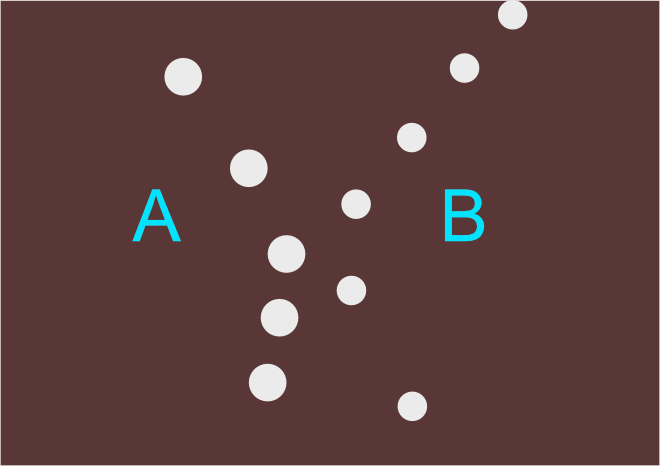
Hints:
Describe the observations from the diagram of the tracks to be used as evidence to describe the motion of A and B.
Describe the motion (speed & direction) of sphere A before and after the collision.
Describe the motion (speed & direction) of sphere B before and after the collision.
Identify the collision point.
Assume both spheres are made of the same material, how would the mass of A compare to B? And how will they affect the collision?
Describe the motions of sphere A and B before and after the collision and what observations you used for your explanations.
Lab notes 5 - Mystery collision
Focus questions:
- Describe how the mystery tracks were created for this diagram of a sphere colliding with a surface.
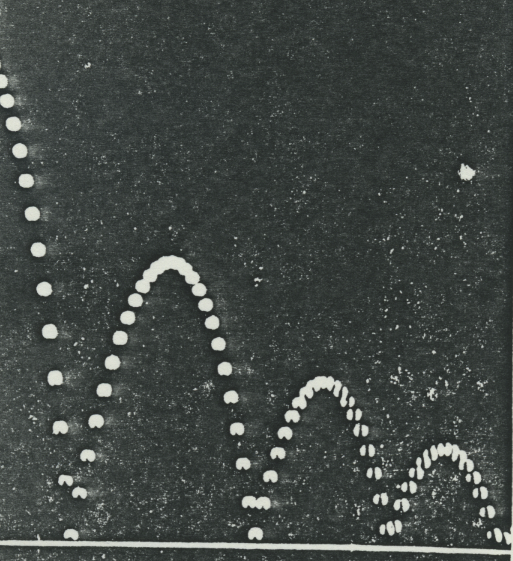
Hints:
Kinetic energy is the energy a body has by being in motion.
Potential energy is the energy a body has relative to something else.
See Energy data sheet for more on kinetic energy, potential energy, gravity and conservation of energy.
Describe the motions of the sphere and its collision with the surface. Include the observations you use for your explanations.
Brain buster
Describe the potential energy of the sphere.
Describe the sphere's kinetic energy.
Describe the sphere's gravitational potential energy.
Identify where the sphere has:
Maximum gravitational potential energy
Minimum gravitational potential energy
Maximum kinetic energy
Minimum kinetic energy
Determine the mathematical relationship between the bounce height and height of its drop.
If energy were conserved, in the collision between sphere and surface, how would the data be affected?
Sketch this sphere's path and its collisions.
Support materials
Mystery Collision 1

Mystery Collision 2

Energy data sheet - Kinetic energy, potential energy, gravity and conservation of energy
Energy transfer of a basketball
When a basketball bounces, it has two different types of energy kinetic energy and potential energy.
- Kinetic energy is the energy a body has by being in motion.
- Potential energy is the energy a body has relative to something else.
Kinetic examples
- When a basketball is sitting on a rack or floor it isn't moving. Therefore, it has no kinetic energy.
- A basketball being dunked (fast moving basketball) has more kinetic energy than a floating lay-up (slow-moving basketball).
Potential
Potential energy is the energy stored in an object relative to something else. Let's continue with the basketball and consider its energy relative to the ground.
- A basketball resting on the floor has no potential energy.
- A basketball at waist level, it has some potential energy.
- Hold it higher, such as up over your head, it has even more potential energy.
Gravity and energy
If you drop a basketball, the force of gravity pulls it down, and as the ball falls, its potential energy changes to kinetic energy. As the ball gets closer to the ground, its potential energy decreases. But, the ball also speeds up, so its kinetic energy increases.
When the basketball hits the court's floor, we say it loses some energy.
However, the law of conservation of energy, tells us it hasn't been lost, but it has been transferred.
It's is transferred to other forms of energy as it travels through the air and hits the floor.
Because of this, when the basketball hits the floor and decompresses not all the energy is used to make it bounce back up. Therefore, it does not go all the way back up to its original height and each following bounce also transfers some energy in other ways besides for bouncing so that after a so many bounces, it will stop bouncing completely. Then we can say the kinetic energy has left the ball!
What about those other forms of energy?
Energy is also transfered to make the sound of the ball hitting the ground when some of the kinetic energy is transferred or changed into sound. Other kinetic energy is transferred to the air as it is pushed aside as the ball moves through it. Other kinetic energy is transferred to the court's surface, and some other energy is transferred to heat (thermal energy) the ball and everything it touches.
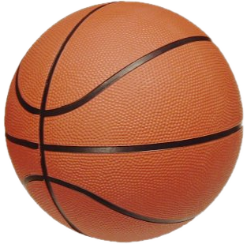
Challenge
Will a basketball warm up after you bounce it? How much do you have to bounce it to notice a change in temperature? How can you find out?
Enjoy!
Conservation of energy
Conserved means maintained or kept the same with out changing. Thus, energy being conserved means the total amount of energy stays the same as it changes, or is transferred, from one form to another.
In other words, if we account for all of the energy transferred after dropping the ball. We could see how all the kinetic energy (motion) is transferred to other forms of energy sound, heat, motion in other objects and that every bit of energy continues as energy (conserved).
If all the basketball's kinetic energy is conserved as kinetic energy, that would mean the potential energy before the first bounce would be the same as the potential energy before the second bounce and each bounce after that. It would not change and the ball would bounce exactly the same on the first, second, and all the following bounces.
Spheres
